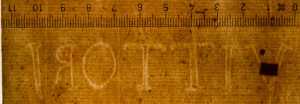Specifications
| Title | The Resurrection of Christ |
|---|---|
| Material and technique | Black chalk |
| Object type |
Drawing
> Two-dimensional object
> Art object
|
| Location | This object is in storage |
| Dimensions |
Height 355 mm Width 170 mm |
|---|---|
| Artists |
Copy after:
Michelangelo Buonarroti
Maker: Anoniem |
| Accession number | I 20 (PK) |
| Credits | Loan Stichting Museum Boijmans Van Beuningen (former Koenigs collection), 1940 |
| Department | Drawings & Prints |
| Acquisition date | 1940 |
| Creation date | in circa 1532-1533 |
| Watermark | geen / none (vH, 6P), 'VITTORI' in the removed backing paper (22 x 102 mm, on P3-6 of 6P) |
| Inscriptions | '220' (on removed backing sheet, lower right, pencil), 'F21' (idem, lower left, below, pencil), '£52' (idem, lower left, below, pencil), 'D'Argenville T.L. Haag / £52.12' ' (idem, centre, pencil) |
| Collector | Collector / Franz Koenigs |
| Mark | T. Lawrence (L.2445), F.W. Koenigs (L.1023a) on removed backing sheet |
| Provenance | Antoine-Joseph Dezallier d'Argenville (1680-1765, L.2951 deest), Paris; his sale, Paris (Rémy) 18-28.01.1779, lot #; Sir Thomas Lawrence (1769-1830, L.2445), London; Art dealer Samuel Woodburn (1781-1853, L.2584), acquired with the Lawrence Collection in 1834, cat. London 1836c, tenth exhibition, no. 56 (Michelangelo Buonarotti); Willem II, King of the Netherlands; his sale, The Hague (De Vries, Roos, Brondgeest) 12.08.1850, lot (?) 122 (Michelangelo Buonarotti, Fl 750 to Woodburn); #his daughter Princess Sophie van Oranje-Nassau (1824-1897) […] - ; Franz W. Koenigs (1881-1941, L.1023a), Haarlem, acquired in 1923 (Michelangelo Buonarotti ?, corrected to Michelangelo); D.G. van Beuningen (1877-1955), Rotterdam, acquired with the Koenigs Collection in 1940 and donated to Stichting Museum Boijmans Van Beuningen |
| Exhibitions | Rotterdam 1997-98 |
| Internal exhibitions |
Rondom Raphaël (1997) |
| Research |
Show research Italian Drawings 1400-1600 |
| Literature | Berenson 1938, no. 1676A (Michelangelo School, copy after a study); De Tolnay 1948, p. 220, no. 114 (copy after Michelangelo); Popham/Wilde 1949, under no. 428 (16th c. copy); Wilde 1953, p. 89 (Clovio); Dussler 1959, no. 690, ill. 267 (Michelangelo); De Tolnay 1960, pp. 20, 179, no. 164, pl 128 (Michelangelo copy); Joannides 2003, under no. 37; Joannides 2007, pp. 200, 486 (one of two copies of a lost M. drawing, generally attr. to G. Clovio, but perhaps by A. Allori); Joannides in London 2017, p. 204 (copy after Michelangelo). |
| Material | |
| Object | |
| Geographical origin | Italy > Southern Europe > Europe |
Do you have corrections or additional information about this work? Please, send us a message

























